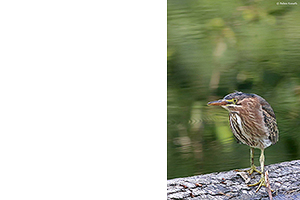 |
Green Heron
Butorides virescens |
|
|
STANFORD LOCATIONS: Uncommon spring and summer visitor to Lagunita. May nest in trees on campus, though no nest has been found there. |
 |
Location |
Type |
Mating System |
Parental Care |
2ndary Diet |
Strategy |
|
|
|
|
I: 21-25 DAYS SEMIALTRICIAL 1 |
|
|
|
0 - 20 feet (0 - 30 feet) |
|
(2-7) MONOG |
MF |
AQUATIC INVERTS |
| BREEDING: | Forested margins of ponds, rivers, lakes, marshes, swamps, mangroves. Occ 2 broods. |
| DISPLAYS: | Raises crest when excited. Male erects neck plumes, swells throat, and calls while strutting (hopping from foot to foot) before female. Territorial display includes forward stretch exposing red mouth lining while calling. |
| NEST: | In absence of trees and shrubs, on tussock in emergent veg. Usu concealed, flat, of interwoven sticks (occ green) and twigs near or over water. Usu unlined or occ lined with finer materials after laying. |
| EGGS: | Light greenish/bluish-green. 1.5" (38 mm). |
| DIET: | Fish, insects, aquatic and terrestrial invertebrates, lower vertebrates. Mostly fish in late summer. Young fed solid regurgitant. |
| CONSERVATION: | Winters s through Antilles to n S.A. Common in most of U.S., but locally rare in w. |
| NOTES: | Usu solitary, occ small colony. Young hatch asynchronously, climb expertly; tended by adults for >1 month after leaving nest. Forages on territory by slowly stalking prey or crouching and waiting for food to come by; occ rakes shallow water bottom with foot to stir up prey. Formerly known as Little Green Heron and Green-backed Heron. |
| ESSAYS: | Tool Using; Nest Lining; Visual Displays; Dabblers vs. Divers. |
| REFERENCES: | Hancock and Kushlan, 1984. |
| Help | Abbreviations | Species-Alphabetical | Species-Taxonomic | Essays-Alphabetical | |
| Except for Stanford Locations, the material in this species treatment is taken, with permission, from The Birder's Handbook (Paul Ehrlich, David Dobkin, & Darryl Wheye, Simon & Schuster, NY. 1988). | |||||